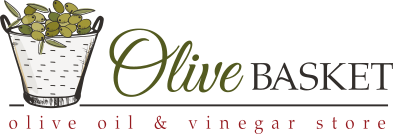Olive Oil Chemistry
We have all heard that olive oil is healthy for us, right? High-quality ones are, and have the chemistry to prove it, but have you ever wondered why olive oil is healthy? This page will explain what chemical properties in high quality olive oil make it so good for us. We'll also explain how our current varietal offerings compare in all of these properties! Let's get started!

Chemical Compounds
Like any complex chemical, olive oil has a lot of compounds in it. In addition to this, there are measurements that can be made to scientifically show how "fresh" the oil is. The six main measurements we look at when selecting varietals for The Olive Basket are:
- Polyphenols
- Free Fatty Acids (FFA)
- Peroxide Value (PV)
- Oleic Acid
- Diacylglycerols (DAGs)
- Pyropheophytin A (PPP)
We will briefly describe each below and compare our current varietal offerings for each measure.
Biophenols

Antioxidant-like substances that are naturally occurring in Extra Virgin Olive Oils, phenols extend the shelf-life of extra virgin olive oil & also determine the “style” in terms of bitterness and pungency.
Generally, when an oil has a high phenol count (presented in parts per million), it will have more “pepper” or more “bitterness”. Many consider phenols to be free-radical “scavengers” and studies have shown numerous health benefits from the biophenols found in quality olive oils.
There is no standard for biophenol content in the olive oil industry, but people who consume olive oil for health reasons like to find the highest phenol count they can.
Free Fatty Acids (FFA)

The lower, the better! An oil with a low (FFA) will have a higher smoke point than an oil with a higher FFA.
The International Olive Oil Council (IOC) requires that this number be below 0.8 in order for an olive oil to be considered Extra Virgin grade.
Peroxide Value (PV)
This number must be equal to or less than 20. This is the primary measurement of the rancidity of a particular extra virgin olive oil. Peroxide value is affected by procedures used in processing and storing of the oil. Peroxide is responsible for color and aroma changes as the oil oxidizes.
Oleic Acid

Oleic Acid- A higher level is better! Oleic acid is responsible for some of the health benefits of EVOO, and its high resistance to free radicals helps to slow down the spread of damaging chemical chain-reactions. Because of its high degree of resistance to attack by oxygen free radicals, higher levels of oleic acid in an olive oil help keep it fresher for longer, by preventing the formation of peroxidized (rancid) fats.
Our bodies absorb any peroxidized fats that we consume and incorporate them into our cells. Oleic acid’s superior resistance to free radical attacks protects our cell membranes, proteins, and DNA from being damaged, as it protects the oil from spoiling.
Substituting oleic acid for saturated fatty acids in animal fats improves cholesterol balance, and research also suggests that oleic acid may have more specific health benefits, such as the ability to help regulate healthy blood pressure by altering cellular signaling. For these and other reasons, the US FDA has approved the health claim that “Limited and not conclusive scientific evidence suggests that eating about 2 tablespoons (23 grams) of olive oil daily may reduce the risk of coronary heart disease due to the monounsaturated fat in olive oil.”
Like biophenols, there is no industry standard on the oleic acid content of olive oil, and also like biophenols, olive oil consumers like to find the highest number they can.
Diacylglycerols (DAGs)
Fresh Olive Oil made from sound fruit should result in a DAG content of 85% or higher whereas the processing of rotten and or fermented olives will produce fresh oil with low DAGs indicating a very short shelf-life.
DAGs typically drop between 20-30% per year depending on storage conditions and FFA. They are highly influenced by heat but not light.
DAGs are important shelf-life indicators and can be used to determine the shelf life (or lack thereof) of an oil at any time in its life.
Recent studies show that many grocery store oils fail DAGs (35% is considered falling in the voluntary Australian standard) which shows a high correlation with sensory defects, more so than any other test.
The degradation of DAGs (rate) are highly predictable over time if initial quality (FFA) is known and storage conditions.
Pyropheophytin A (PPP)
This test measures chlorophyll degradation in Olive Oil. PPP is the most sensitive method (ratio) able to detect the presence of deodorized (soft-column refined, thermally treated) oils.
Recent studies show that many grocery store oils fail PPP (17% is considered falling in the voluntary Australian standard).
Freshly made oil should have a PPP of close to zero.
Soft column refining is generally used to strip out sensory defects and otherwise neutralize some chemical parameters in old oils or oils made from over-ripe and fermented (late season) olives so that they can pass typical authenticity tests undetected.
PPP are highly influenced by heat and by light.
In ideal storage conditions, they should only increase between 6-8% per year! An oil with an extremely high PPP is a clear indication that “something” is wrong or amiss. Either the oil is severely aged, deodorized or has had continuous light exposure (clear packaging!) for extended time periods and/or higher than normal storage temperatures.
How do our Olive Oils compare?
As you might expect, the oils sold at The Olive Basket are among the best in the world. That is not an empty claim, we can prove it with the chemistry!
We display lab results right here on the website for any of the Extra Virgin Olive Oils we sell, so you can see the quality right there in the numbers.
Our Fused and Infused Oils are made with the same EVOOs that we sell, so while they can't be considered EVOO, you can rest assured that they maintain the highest quality.




